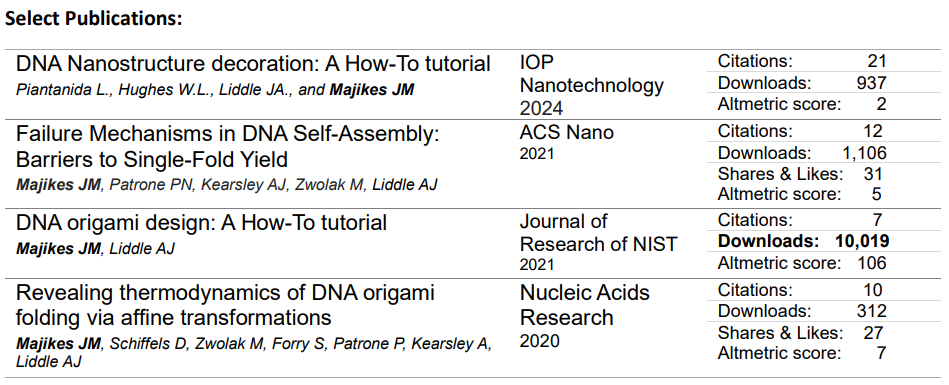(4bw) Self-Assembly Design, Cooperativity, & Thermodynamics in Synthetic Nanostructures Fabricated from DNA
AIChE Annual Meeting
2024
2024 AIChE Annual Meeting
Meet the Candidates Poster Sessions
Meet the Faculty and Post-Doc Candidates Poster Session
Sunday, October 27, 2024 - 1:00pm to 3:00pm
I am a research scientist working at the National Institute of Standards and Technology (NIST), on the cooperative energetics, and design implications thereof, of DNA origami nanofabrication systems.
I plan to obtain a tenure track position and build a research group focused on molecular programming and self-assembly based nanofabrication, with the long-term goal of engineering nanostructures capable of performing meaningful chemo-mechanical work from small molecule fuel.
I have intentionally cultivated a generalist skillset that I believe to be indispensable in the professoriate and have a track record of excellence in leadership within my field. I have a record of high-quality publications in DNA origami energetics, including multiple well-received and widely read tutorials for DNA nanofabrication. I have been interviewed by the BBC News Radio Hour, have served on the executive board of a grassroots textbook initiative of more than 140 people for three years, have co-organized the local Mid-Atlantic DNA Nanotechnology conference in 2017, 2019, & 2024, and have co-chaired the Foundations of Nanoscience international conference in 2023 and 2024.
Research Interests: Self-assembly design, cooperativity, & thermodynamics in DNA origami
Broadly, my interests are in the design of complex cooperative self-assembly systems, using DNA, and in how to lower the barrier to entry for that design to facilitate their industrial relevance. To date, my work has emphasized the relationship between DNA nanostructure design and the cooperativity in their self-assembly and in their assembly yield. My publication topics range from examining the role of entropy penalties in DNA origami folding, to the identification of kinetically trapped states in folding, to broader studies of DNA nanostructure design best practices. My work has highlighted that while DNA nanofabrication is surprisingly straightforward to implement, and while DNA energetics are well-understood in biology, the complex interactions that enable synthetic DNA self-assembly to fabricate 3D nanostructures in high yield are as yet poorly understood.
Since starting my post-Doc in 2017, I have published ten papers - one as anchor author and five as first author, with two more manuscripts currently under review. I have also applied for two patents.
Pursuing this focus, especially with an eye towards future practical industrial application, has led me to develop both experimental and theoretical expertise, as well as the communicative and interpersonal skills necessary to recruit and coordinate team members with a broad array of skills from a variety of disciplines. I believe this approach is necessary both for impactful science, and for pursuing funding.
Moving forward, I will expand my areas of expertise to the cooperativity of the energy landscape of 3D motion in these nanostructures, particularly for aptamer driven conformational changes. This will build toward best practices in adaptation of aptamers for 3D motion, and ultimately to the long-term project of performing meaningful chemo-mechanical work in self-assembled systems that have been engineered from the ground up.
Funding: I initially obtained an NRC postdoctoral fellowship (2017-2020). During this time, I made the most of a federal employee’s limited opportunities to apply for funding by working with an interdisciplinary team of eight to compete for highly competitive internal grant and by submitting to multiple DARPA and BARDA programs. Since working as a Research Scientist at Theiss Research, I have funded my 2023-2024 salary through a NIST Notice of Funding Opportunity.
Teaching Interests: Aligning incentives in technical training to build soft skills
What excites me most about the opportunity to teach is the opportunity to tune the incentives in otherwise technical training to help budding engineers build critical soft skills for their careers. This is most compatible with a project based flipped classroom environment, and I am particularly interested in teaching courses that are amenable to that style.
As an example: I am especially interested in teaching thermodynamics, as I believe there are many opportunities to make exercises from uncertainty propagation between measurements, models of the system in question, and engineering decisions for that system. The difficulty of uncertainty propagation exercises can be scaled between quick individual practice and larger, long-term group projects; and their nature requires a thorough understanding of both theory and experiment that can be easily linked to real-world uncertainty and decision making.
In addition to multimodal thinking, another key soft skill I want to build incentives for is students’ ability to judge technical competence, both their own and others. This skill is absolutely vital in team settings, and often separates good engineers from great ones. To this end, I hope to build a series of interlocking individual exercises, team exercises, and reflection exercises in a flipped classroom in which students are rewarded not just for getting the right answer, but also for correctly determining for themselves whether they or their classmates got the right answer and reflecting on the reasons why or why not.
This strategy can be even further enhanced if digital tools are available to provide rapid feedback. In such an environment, students can be given numerous low-stakes incentives and opportunities to reflect on how to best leverage their competencies, and the competencies of their changing team composition. Ultimately, I hope meaningful practice with this skill will in turn improve their ability to identify and utilize team expertise throughout their careers.
While at NIST, I have not had many opportunities to pursue these classroom interests, but I believe my track record of mentoring 20+ undergraduates in the last decade, and in running meetings ranging from 6-50+ attendees in the Art of Molecular Programming textbook initiative and in the NCSU Graduate Student Association have given me many of the fundamental skills required to be a success in the classroom.
